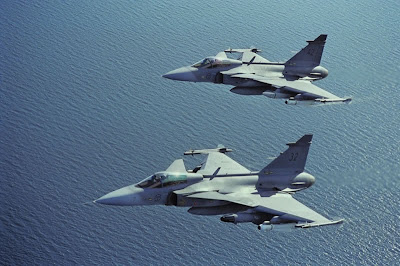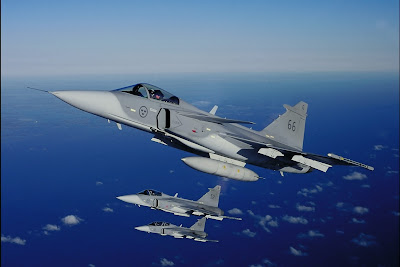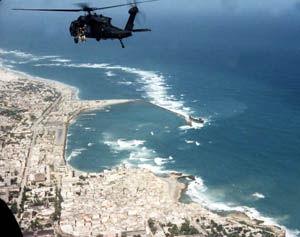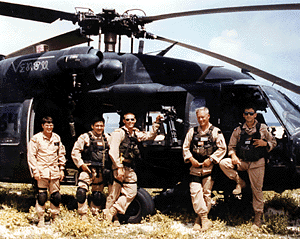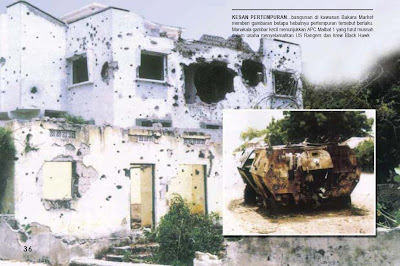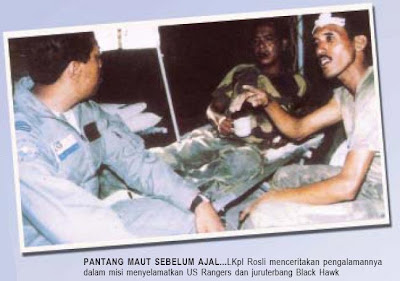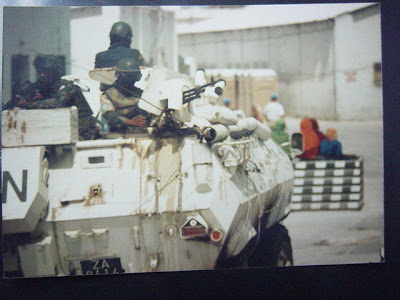The Battle of Mogadishu (also referred to as the Battle of the Black Sea) or for Somalis The Day of the Rangers (Somali: Ma'alintii Rangers) was a battle that was part of Operation Gothic Serpent that was fought on October 3 and 4, 1993, in Mogadishu, Somalia, by forces of the United States supported by UNOSOM II against Somali militia fighters loyal to warlord Mohamed Farrah Aidid, with support from armed civilian fighters. The battle is also referred to as the First Battle of Mogadishu to distinguish it from the later Second Battle of Mogadishu. Task Force Ranger, which consisted of an assault force made up of US Army Delta Force, Ranger teams, an air element provided by the 160th Special Operations Aviation Regiment, four Navy SEAL operators from SEAL Team Six, and members of the Air Force Pararescue/Air Force Combat Controllers, executed an operation which involved traveling from their compound on the outskirts of the city to capture tier one personalities of the Habr Gidr clan, headed by Aidid. The assault force consisted of nineteen aircraft, twelve vehicles and 160 men. During the operation, two U.S. UH-60 Black Hawk helicopters were shot down by rocket-propelled grenades, and three others were damaged. Some of the soldiers were able to evacuate wounded back to the compound, but others were trapped at the crash sites and cut off. An urban battle ensued throughout the night. Early the next morning, a combined task force was sent to rescue the trapped soldiers. It contained soldiers from Pakistan, Malaysia, and the U.S. 10th Mountain Division. They assembled some 100 vehicles, including Pakistani tanks (M48s) and Malaysian Condor armored personnel carriers, and were supported by U.S. A/MH-6 Little Bird, and UH-60 Black Hawk helicopters. This task force reached the first crash site and led the trapped soldiers out. The second crash site was overrun and pilot Mike Durant, the lone surviving American from that site, was taken prisoner but later released.
Somali casualty figures are unknown, but American estimates are that between 1,000 and 1,500 Somali militiamen and civilians lost their lives in the battle, with injuries to another 3,000-4,000. However, the International Committee of the Red Cross estimated 200 Somali civilians killed and several hundred wounded in the fighting. The book Black Hawk Down: A Story of Modern War estimates more than 700 Somali militiamen dead and more than 1,000 wounded, but the Somali National Alliance in a Frontline documentary on American television acknowledged only 133 killed in the whole battle. Eighteen American soldiers died and 73 were wounded (another American soldier, Delta operator SFC Matt Rierson, was killed in a mortar attack two days later). Among UN forces, one Malaysian soldier died; seven Malaysians and two Pakistanis were wounded.
Background to the battle
In January 1991, the President of Somalia, Mohammed Siad Barre, was overthrown by a coalition of opposing clans called the United Somali Congress. After this revolution, the coalition divided into two groups. One was led by Ali Mahdi Muhammad, who became president; and the other, by Mohammed Farah Aidid. In total, there were four opposing groups: the United Somali Congress (USC), Somali Salvation Democratic Front (SSDF), Somali Patriotic Movement (SPM), and Somali Democratic Movement (SDM), which continued to fight over the domination of Somalia. In June 1991, a ceasefire was agreed to, but failed to hold. A fifth group, the Somali National Movement (SNM), had already seceded from the northwest portion of Somalia in June. The SNM renamed it the Somaliland Republic, with its leader Abdel-Rahman Ahmed Ali as president.
In September 1991, severe fighting broke out in Mogadishu, which continued in the following months and spread throughout the country, with over 20,000 people killed or injured by the end of the year. These wars led to the destruction of the agriculture of Somalia, which in turn led to starvation in large parts of the country. The international community began to send food supplies to halt the starvation, but vast amounts of food were hijacked and brought to local clan leaders, who routinely exchanged it with other countries for weapons. An estimated 80 percent of the food was stolen. These factors led to even more starvation, from which an estimated 300,000 people died, and another 1.5 million people suffered, between 1991 and 1992. In July 1992, after a ceasefire between the opposing clan factions, the United Nations (UN) sent 50 military observers to watch the distribution of the food.
Operation Provide Relief began in August 1992, when the U.S. President George H. W. Bush announced that U.S. military transports would support the multinational UN relief effort in Somalia. Ten C-130s and 400 people were deployed to Mombasa, Kenya during Operation Provide Relief, airlifting aid to remote areas in Somalia and reducing reliance on truck convoys. One member of the 86th Supply Squadron, USAFE's only contribution to the operation, was deployed with the ground support contingent. The Air Force C-130s delivered 48,000 tons of food and medical supplies in six months to international humanitarian organizations trying to help the over three million starving people in the country. When this proved inadequate to stop the massive death and displacement of the Somali people (500,000 dead and 1.5 million refugees or displaced), the U.S., in December 1992, launched a major coalition operation to assist and protect humanitarian activities, Operation Restore Hope, under which the United States would assume the unified command of the new operation, in accordance with Resolution 794 (1992). The U.S. Marine Corps landed with the 15th Marine Expeditionary Unit in Mogadishu and, with elements of 1st Battalion, 7th Marines and 3rd Battalion, 11th Marines, secured nearly one-third of the city, the port, and airport facilities, to facilitate airlifted humanitarian supplies in two weeks time. Elements of the 2nd Battalion, 9th Marines and 1st Battalion, 7th Marines quickly secured routes to Baidoa, Balidogle and Kismayo, then were reinforced by the 3rd Assault Amphibian Battalion and the US Army's 10th Mountain Division.
Mission shift
On March 3, 1993, the U.N. Secretary-General submitted to the U.N. Security Council his recommendations for effecting the transition from UNITAF to UNOSOM II. He indicated that since the adoption of Council resolution 794 (1992) in December 1992, the presence and operations of UNITAF had a positive impact on the security situation in Somalia and on the effective delivery of humanitarian assistance (UNITAF deployed some 37,000 personnel over forty percent of southern and central Somalia). However, there was still no effective government, police, or national army with the result of serious security threats to UN personnel. To that end, the U.N. Security Council authorized UNOSOM II to establish a secure environment throughout Somalia, to achieve national reconciliation so as to create a democratic state.
At the Conference on National Reconciliation in Somalia, held on March 15, 1993, in Addis Ababa, all fifteen Somali parties agreed to the terms set out to restore peace and democracy. Yet by May it became clear that, although signatory to the March Agreement, General Mohammed Farrah Aidid's faction would not cooperate in the Agreement's implementation.
UNOSOM II's attempts to implement disarmament led to violence. On June 5, 1993, twenty-four Pakistani troops in the UN force were killed in heavy fighting in an area of Mogadishu controlled by Aidid. The next day, the United Nations Security Council issued Resolution 837, calling for the arrest and trial of those responsible for the ambush.
Attack on safe house
On July 12, 1993, a United States-led operation was launched on what was believed to be a safe house in Mogadishu where members of Aidid's Habar Gidir clan were meeting. In reality, elders of the clan, not gunmen, were meeting in the house. According to U.N. officials, the agenda, advertised in the local newspaper,[citation needed] was to discuss ways to peacefully resolve the conflict between Aidid and the multinational task force in Somalia, and perhaps even to remove Aidid as leader of the clan.
During the 17-minute combat operation, U.S. Cobra attack helicopters fired 16 TOW missiles and thousands of 20-millimeter cannon rounds into the compound, killing 73 of the clan elders. It would also lead to the deaths of four journalists, Dan Eldon, Hos Maina, Hansi Kraus and Anthony Macharia, who were killed by angry Somali mobs when they arrived to cover the incident.
Some believe that this American attack was a turning point in unifying Somalis against the U.S. efforts in Somalia, including moderates and those opposed to the Habar Gidir.
Battle of Mogadishu
On October 3, 1993, Task Force Ranger, U.S. Special Operations Forces composed mainly of Bravo Company 3rd Battalion, 75th Ranger Regiment, 1st Special Forces Operational Detachment-Delta (1st SFOD-D; better known as “Delta Force”) operators, and aviation support from the 160th Special Operations Aviation Regiment (Airborne) (“The Night Stalkers”), attempted to capture Aidid's foreign minister, Omar Salad Elmi, and his top political advisor, Mohamed Hassan Awale.
The plan was to fast rope from hovering MH-60 Black Hawk helicopters, capture the targets, and load them onto a ground convoy for transport back to the U.S. compound. Four Ranger chalks commanded by Captain Michael Steele, also inserted by helicopter, were to provide a secure square perimeter on the four corners of the operation's target building.
The ground extraction convoy was supposed to reach the captive targets a few minutes after the beginning of the operation. However, it ran into delays. Somali citizens and local militia formed barricades along the streets of Mogadishu with rocks and burning tires, blocking the convoy from reaching the Rangers and their captives.
Other complications arose. A Ranger was seriously injured during the insertion. PFC Todd Blackburn fell while fast roping from a helicopter hovering 70 feet (21 m) above the streets. Minutes later, a MH-60 Black Hawk helicopter, Super 61 piloted by CW3 Cliff Wolcott, was shot down by a rocket propelled grenade.
A Combat Search and Rescue team, led by TSgt Scott Fales of the Air Force Pararescuemen, were able to rope down to Super 61's crash site despite an RPG hit that crippled their helicopter. They found the pilots dead and five injured inside the Black Hawk. Under intense fire, the team removed the injured to a nearby collection point, where they built a make-shift shelter for the wounded using Kevlar floorboards from the Black Hawk.
There was confusion between the ground convoy and the assault team. The assault team and the ground convoy waited for twenty minutes just out of sight of each other, ready to move, but each under the impression that they were to be first contacted by the other. During the wait, a second Black Hawk helicopter, Super 64 piloted by CW3 Michael Durant, was downed.
Most of the assault team went to the first crash site for a rescue operation. Upon reaching the site, about 90 Rangers and Delta operators found themselves under siege from heavy militia fire. Despite air support, the Rangers were effectively trapped for the night. With a growing number of wounded needing shelter, the Rangers occupied several nearby houses. Outside, a stiff breeze stirred up blinding brown clouds of dust.
The crew of Super 64 a month before the Battle of Mogadishu. From left: Winn Mahuron, Tommy Field, Bill Cleveland, Ray Frank and Mike Durant.
At the second crash site, two Delta snipers, SFC Randy Shughart and MSG Gary Gordon, were inserted by helicopter (at their own request, permission was denied twice by Command but granted when they persisted and made a third request) to protect the injured crew from the approaching mob. Both snipers were later killed when the site was overrun by Somali militiamen. The Black Hawk's pilot, CW3 Michael Durant, who was seriously injured in the crash, was taken hostage. For their actions, Shughart and Gordon were posthumously awarded the Medal of Honor.
Repeated attempts by the Somalis to mass forces and overrun the American positions in a series of firefights near the crash sites were neutralized by aggressive small arms fire and by strafing and rocket attacks from AH-6J Little Bird helicopter gunships of the Nightstalkers, the only air support equipped to operate at night. The Somali National Alliance militia casualties were reported as 700 killed and about 1000 wounded.
A relief convoy of men from Task Force 2-14 Infantry, 10th Mountain Division, accompanied by Malaysian and Pakistani UN forces, arrived in the early morning. No contingency planning or coordination with UN forces had been arranged prior to the operation; consequently, the recovery of the surrounded U.S. soldiers was significantly complicated and delayed. Determined to protect all members of the rescue convoy, Gen. Garrison made sure to roll out in force. When the convoy finally pushed into the city, it consisted of more than 100 vehicles including Malaysian forces' German made Condor APCs, four Pakistani tanks, American Humvees and several five-ton flatbed trucks. This two mile long column was supported by several other Black Hawks and Cobra assault helicopters stationed with the 10th Mountain Division. The "Little Birds" of Task Force Ranger continued their defense of the downed crew and rescuers of Super 61 throughout the night, the Night Stalkers being some of the only pilots trained and practiced in nighttime flying.
The battle was over by October 4, 1993, at 6:30 AM. American forces were finally evacuated to the UN Pakistani base by the armored convoy and the “Mogadishu Mile.” In all, 18 U.S. soldiers died of wounds from the battle and another 83 were injured. After the battle, the bodies of several US casualties of the conflict, members of the Black Hawk "Super 64" crew and their protectors, Delta Operators SFC Shughart and MSG Gordon, were dragged through the streets of Mogadishu by crowds of local civilians and SNA forces. The Malaysian forces lost one soldier and had seven injured, while the Pakistanis suffered two injured. Casualties on the Somali side were heavy, with estimates on fatalities ranging from 315 to over 2,000 people. The Somali casualties were a mixture of militiamen and local civilians. Somali civilians suffered heavy casualties due to the dense urban character of that portion of Mogadishu. Two days later, a mortar round fell on the U.S. compound, killing one U.S. soldier, SFC Matt Rierson, and injuring another twelve. Two weeks after the Battle of Mogadishu General Garrison officially accepted responsibility. In a handwritten letter to President Clinton, Garrison took full responsibility for the outcome of the battle. He wrote that the Task Force Ranger had adequate intelligence for the mission and that their objective (capturing targets from the Olympic Hotel) was met.
What began as a peacekeeping mission to provide relief to the starving people of Somalia essentially ended with a firefight during the Battle of Mogadishu. After all of the U.S. troops were withdrawn in March 1994, 20,000 U.N. troops were still in Somalia. By the late Spring of 1994 all of the remaining U.N. troops were withdrawn, ending UNOSOM-II.
Order of battle
U.S. and UNOSOM
Units involved in the battle:
Task Force Ranger, including :
C Squadron, 1st Special Forces Operational Detachment-Delta (1st SFOD-D) — aka "Delta Force"
Bravo Company, 3rd Ranger Battalion, 75th Ranger Regiment
1st Battalion, 160th Special Operations Aviation Regiment (Airborne) (The Night Stalkers) with MH-6J and AH-6 "Little Birds" and MH-60 A/L Black Hawks
Combat Controllers and Pararescuemen from the USAF 24th Special Tactics Squadron
SEAL Team Six (four Navy SEAL operators)
CVN-72 USS Abraham Lincoln & Carrier Air Wing 11
Task Force-10th Mountain Division, including:
2nd Battalion, 14th Infantry Regiment,
1st platoon, C Company, 1st Battalion, 87th Infantry Regiment
15th FF Battalion, of the Frontier Force Regiment, Pakistan Army
19 Lancers of the Pakistan Army
United Nations Forces
19th Battalion, Royal Malay Regiment of the Malaysian Army
10th Battalion Baloch Regiment of the Pakistan Army, (less two companies who were held in reserve)
Somali militias
The size and organizational structure of Somali forces are not known in detail. In all, between 2,000-4,000 regular militia members are believed to have participated, almost all of which belonged to Aidid's Somali National Alliance, drawing largely from the Habar Gedir clan.
Consequences of the operation
In a national security policy review session held in the White House on October 6, 1993, U.S. President Bill Clinton directed the acting chairman of the Joint Chiefs of Staff, Admiral David E. Jeremiah, to stop all actions by U.S. forces against Aidid except those required in self-defense. He also reappointed Ambassador Robert B. Oakley as special envoy to Somalia in an attempt to broker a peace settlement and then announced that all U.S. Forces would withdraw from Somalia no later than March 31, 1994. On December 15, 1993, Secretary of Defense Les Aspin stepped down, taking much of the blame for what was deemed a failed policy. A few hundred Marines remained offshore to assist with any noncombatant evacuation mission that might occur regarding the 1,000-plus U.S. civilians and military advisers remaining as part of the U.S. liaison mission.
The Ready Battalion of the 24th Infantry Division, 1-64 Armor, was sent from Fort Stewart, Georgia, to Mogadishu in the wake of this battle to secure the city and prevent a recurrence of hostilities.
All U.S. personnel were finally withdrawn by March 1995.
Service analyses of the action later identified three factors in the failure of the raid to achieve its objectives without serious casualties on both sides:
A failure of intelligence gathering, particularly in relying on local intelligence sources only and failing to recognize Aidid's capability in urban guerilla warfare;
A lack of political support for the Task Force Ranger mission, reflected in denial or removal of military support assets that would have aided the force, such as M1 Abrams tanks , AC-130 Spectre gunships, and M2 Bradley IFVs.
A lack of decisive force by Task Force Ranger, including insufficient troops, equipment, and weaponry.
All three factors contributed to the decision to use tactics successful in previous raids but inappropriate to downtown Mogadishu, and to launch the operation during daylight instead of at night. However, by night, the meeting which the US wished to raid and capture the lieutenants may have ended, giving them no choice but to launch it in the day.
Policy changes
Rangers under fire in a Somali street near Irene’s target building on 3 October 1993. This is the only known photograph taken by American forces from the ground during the battle. The target building looms in the background to the right. Photograph by Lt. James Lechner. (Lt. Col today)
The Battle of Mogadishu led to a shift in American foreign policy. The Clinton administration became increasingly reluctant to use military intervention in Third World conflicts peripherally related to the national interest or national defense of the United States, such as the Rwandan Genocide, the mass murder of an estimated 800,000 to 1,071,000 ethnic Tutsis and moderate Hutus by Hutu militia groups in Rwanda in 1994.
President Clinton also refused to mobilize U.S. ground troops in fighting the Bosnian Serb Army in Bosnia and Herzegovina in 1995 and the Yugoslav Army in the Federal Republic of Yugoslavia (specifically, the province of Kosovo) in 1999.
Links with Al-Qaeda
There have been allegations that Osama bin Laden's Al-Qaeda movement was involved in training and funding of Aidid's men. In his 2001 book, Holy War, Inc., CNN reporter Peter Bergen interviewed bin Laden who affirmed these allegations. According to Bergen, bin Laden asserted that fighters affiliated with his group were involved in killing American troops in Somalia in 1993, a claim he had earlier made to the Arabic newspaper Al-Quds Al-Arabi (English:Arab Jerusalem). The Al-Qaeda fighters in Somalia are rumored to have included the organization's military chief, Mohammed Atef, later killed by U.S. forces in Afghanistan.
Four and a half years after the Battle of Mogadishu, in an interview in May 1998,[18] bin Laden disparaged the withdrawal of U.S. troops from Somalia.
Black Hawk Down
In 1999, writer Mark Bowden published the book Black Hawk Down: A Story of Modern War, which chronicles the events that surrounded the battle.
The book was adapted into the 2001 film Black Hawk Down, produced by Jerry Bruckheimer and directed by Ridley Scott. The film describes the events surrounding the operation and some of the acts of bravery seen on that day. There are obvious differences between the book and the movie, which left out central sections and themes of the book, such as the involvement of civilians in the battle, and de-emphasized the key decision to stay in the area after the initial operation was completed, among others.
According to journalist Kevin Sites—one of the few Westerners to have reported from Mogadishu since the events of 1993—thousands went to see the film when it premiered in Somalia in 2002. Many people in Mogadishu were angered by it, calling it propaganda that focused on the 18 Americans killed and 83 wounded in the 18-hour battle, when an estimated 315[16] to 2,000 Somalis were also killed. When it was learned that the battle has been turned into a game for PC, Xbox, and PlayStation 2, Somalis said it made a mockery of a real-life tragedy.[19]
Mike Durant told his own story in his 2003 book In the Company of Heroes.
Later, in 2005, Matthew Eversmann, leader of Chalk 4 during the battle, compiled several different accounts into a book called The Battle of Mogadishu.
Known casualties
Malaysia
Private Mat Aznan Awang, driver of a Malaysian Condor armoured personnel carrier, was killed when his vehicle was hit by an RPG on October 3. He was posthumously promoted to corporal, and awarded the Seri Pahlawan Gagah Perkasa medal.
Pakistan
A Pakistani soldier was wounded when his vehicle was attacked by Somali insurgents. Another Pakistani soldier was also wounded. These were the only casualties among Pakistani troops, meaning that Pakistan was the only country that participated in the battle and sustained no fatalities.
Somalia
Ambassador Robert Oakley, the US special representative to Somalia, is quoted as saying: "My own personal estimate is that there must have been 1,500 to 2,000 Somalis killed and wounded that day, because that battle was a true battle. And the Americans and those who came to their rescue, were being shot at from all sides ... a deliberate war battle, if you will, on the part of the Somalis. And women and children were being used as shields and some cases women and children were actually firing weapons, and were coming from all sides. Sort of a rabbit warren of huts, houses, alleys, and twisting and turning streets, so those who were trying to defend themselves were shooting back in all directions. Helicopter gun ships were being used as well as all sorts of automatic weapons on the ground by the U.S. and the United Nations. The Somalis, by and large, were using automatic rifles and grenade launchers and it was a very nasty fight, as intense as almost any battle you would find."
However, Aidid himself claimed that only 315 - civilians and militia - were killed and 812 wounded. Captain Haad, in an interview on American public television, said 133 of the SNA militia were killed.
United States
| Name | Action | Medal |
|---|
| 1st Special Forces Operational Detachment-Delta (Delta Force) |
|---|
| MSG Gary Gordon | Killed defending the crew of Super Six-Four (Michael Durant) | Medal of Honor |
| SFC Randy Shughart | Killed defending the crew of Super Six-Four (Michael Durant) | Medal of Honor |
| SSG Daniel Busch | Crashed on Super Six-One, died from wounds received defending the downed crew | Silver Star |
| SFC Earl Fillmore | Killed moving to the first crash site | Silver Star |
| SFC Matt Rierson | Killed on October 6 , 1993 by a mortar which landed just outside the hangar | Silver Star |
| MSG Tim "Griz" Martin | Died from wounds received on the Lost Convoy | Silver Star and Purple Heart.[22][23] |
| 3rd Ranger Battalion, 75th Ranger Regiment |
|---|
| CPL Jamie Smith | Died of wounds with the pinned-down force around crash site one | Bronze Star with Valor Device andOak leaf cluster,
Purple Heart |
| SPC James Cavaco | Killed on the Lost Convoy | Bronze Star with Valor Device |
| SGT Casey Joyce | Killed on the Lost Convoy | Bronze Star with Valor Device |
| PFC Richard "Alphabet" Kowalewski | Killed on the Lost Convoy | Bronze Star with Valor Device |
| SGT Dominick Pilla | Killed on Struecker's convoy | Bronze Star with Valor Device |
| SGT Lorenzo Ruiz | Killed on the Lost Convoy | Bronze Star with Valor Device |
| 160th SOAR (Nightstalkers) |
|---|
| SSG William Cleveland | Crew chief on Super Six-Four-killed | Silver Star,
Bronze Star,
Air Medal with Valor Device |
| SSG Thomas Field | Crew chief on Super Six-Four-killed | Silver Star,
Bronze Star,
Air Medal with Valor Device |
| CW4 Raymond Frank | Copilot of Super Six-Four-killed | Silver Star,
Air Medal with Valor Device |
| CW3 Clifton "Elvis" Wolcott | Pilot of Super Six-One and died in crash | Distinguished Flying Cross,
Bronze Star,
Air Medal with Valor Device |
| CW2 Donovan "Bull" Briley | Copilot of Super Six-One and died in crash | Distinguished Flying Cross,
Bronze Star,
Air Medal with Valor Device |
| 2nd Battalion 14th Infantry Regiment, 2nd Brigade 10th Mountain Division |
|---|
| SGT Cornell Houston | Killed on the rescue convoy | Bronze Star with Valor Device,
de Fleury Medal |
| PFC James Martin | Killed on the rescue convoy | Purple Heart
|
Malaysian Battalion (MALBATT)
Allahyarham Corporal Mat Aznan Awang, before the mission
A contingent known as MALBATT was sent under the United Nations Operation in Somalia II (UNOSOM II) to take appropriate action, including enforcement measures, to establish throughout Somalia a secure environment for humanitarian assistance. During its deployment, MALBATT was involved in the Battle of Mogadishu which saw 1 personnel killed in action and 7 others wounded in action during the relief operations to aid the surrounded troops of the United States' Task Force Ranger. On 18 January 1994, Lieutenant General Aboo Samah Bin Aboo Bakar was appointed the Commander of UNOSOM II forces. His appointment also saw the United Nations revise the mandate of UNOSOM II to stop using "coercive methods" in the discharge of their duties while retaining "some capability to defend its personnel if circumstances so warrant










